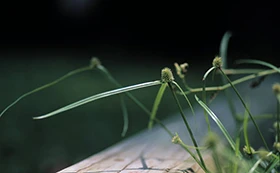
Kyllinga is a relative newcomer on the weed scene, but it can spread like crazy, damaging landscaping as well as lawns. The weedy sedge tends to thrive in soil that remains wet for an extended period of time and receives full sun, although it will do just fine in partial shade.
According to the Cornell Cooperative Extension, kyllinga moves easily from landscape beds to nearby turf and only becomes evident in later summer. The seeds can be spread by mowing equipment and even technicians’ clothing, taking it from property to property. Close mowing can also cause a kyllinga outbreak as the lawn grass is unable to spread and compete, according to the University of California Division of Agriculture and Natural Resources.
But kyllinga also spreads through short rhizomes, or underground stems. That means even if technicians pull up the weed, each node can still reproduce. While pre-emergent control is the preferred option, there are ways to deal with a problem area.
To spot kyllinga, technicians should be on the lookout for weeds that look like nutsedge but with less erect and smaller leaves. Infestations can form dense mats in a turfgrass stand, says Jim Brosnan, associate professor of turf and ornamental weed science at the University of Tennessee. “Kyllingas can persist under low mowing heights, and unlike yellow and purple nutsedge, these plants produce flowers even under regular mowing,” he adds.
To treat it, there are numerous options for warm season lawns, Brosnan says, naming the following:
- Sulfosulfuron
- Sulfentrazone
- Sulfentrazone and imazethapyr
- Sulfentrazone and metsulfuron
- Sulfentrazone and quinclorac
- Imazaquin
- Flazasulfuron
- Trifloxysulfuron
- Halosulfuron
- Thiencarbazone, foramsulfuron and halosulfuron
For cool season lawns, the options are fewer: sulfentrazone, halosulfuron and sulfentrazone with quinclorac.
A good place to start is making sure that lawns aren’t being overwatered. It’s also a smart idea to clean mowers as much as possible when technicians have been dealing with an infestation so that seeds aren’t spread from property to property.
While early prevention is the best option, with the proper care and applications, technicians can get rid of an infestation and return a lawn to its former green glory.





